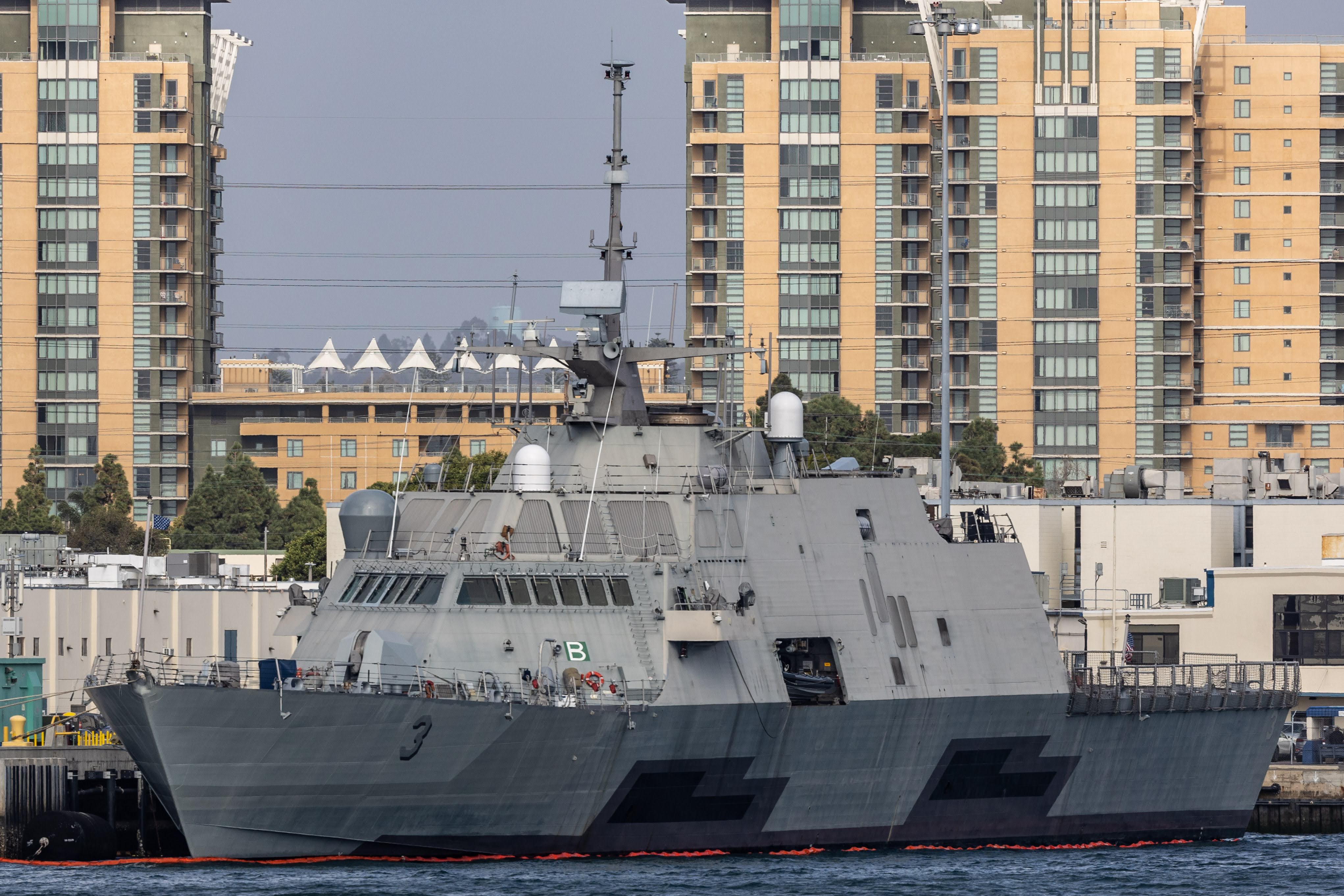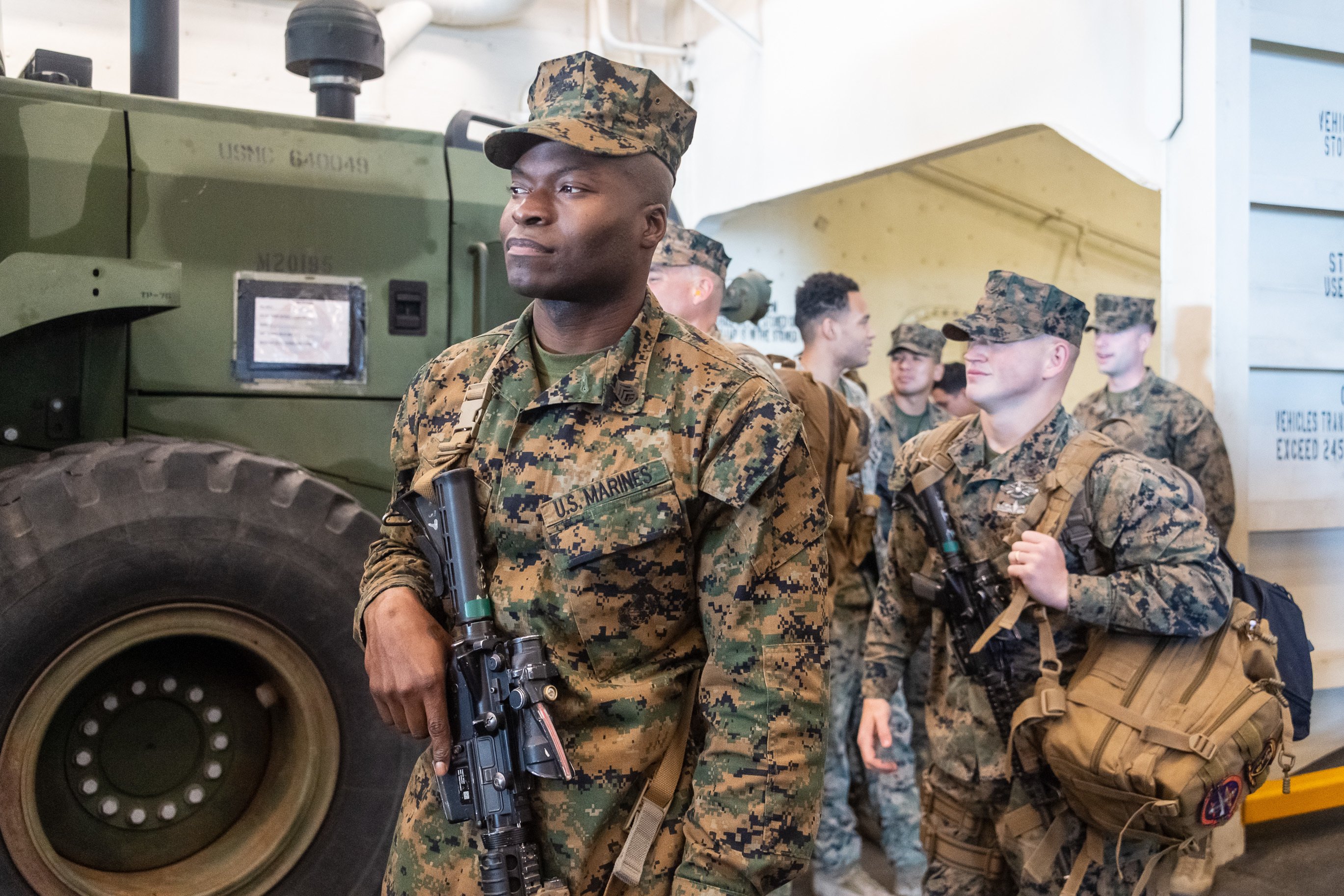
THE PENTAGON – The Navy wants to decommission 24 ships in the upcoming fiscal year to save $3.6 billion over the next five years, the service announced today.
As part of its Fiscal Year 2023 budget request, the Navy plans to decommission nine Freedom-class Littoral Combat Ships, five Ticonderoga-class cruisers, two Los Angeles-class submarines, four Landing Dock Ships, two oilers and two Expeditionary Transfer Docks.
Explaining the LCS decommissionings, Navy deputy assistant secretary for budget Rear Adm. John Gumbleton cited the service’s decision to abandon the anti-submarine warfare mission package for the LCS class because the Constellation-class frigate will have that capability.
“The programmatic decision was actually looking at the ASW variant. And the ASW variant – mission module – huge challenges, not going to work. And we’re buying in this budget our fourth frigate. And the fourth frigate has what we believe is going to be an effective ASW capability and so that’s where we chose to take risk in our LCS portfolio,” Gumbleton told reporters in a roundtable on Monday morning.
The first Constellation-class frigate isn’t slated to deliver until 2026 and won’t reach initial operating capability until 2030.
“They also do happen to be Freedom class, which also happens to have the drive train challenge. But if I were to be completely transparent, that drivetrain fix isn’t an exorbitant amount of money,” Gumbleton added, referring to the nine LCS. “But when you target your savings at one variant, there’s savings programmatically instead of having to sustain two different lines. So, collectively, ASW [and] drive train, led us to this.”
USS Fort Worth (LCS-3) is one of the nine LCS the Navy wants to decommission. The Navy tried to decommission Fort Worth in both of the FY 2021 and FY 2022 budget cycles, but Congress blocked the proposals. The service commissioned Fort Worth in 2012. While the Freedom LCS have experienced a class-wide issue with the combining gear that marries the gas turbines to its diesel engines, Fort Worth has a different combining gear mechanism built by a different manufacturer.
Asked about decommissioning the nine LCS, Meredith Berger, who is currently performing the duties of the under secretary of the Navy, said doing so allows the Navy to “free ourselves of some really costly repairs and maintenance.”
Service officials described the FY 2023 budget request as meeting the priorities of the revised National Defense Strategy, Navy Secretary Carlos Del Toro’s strategic objectives, and Chief of Naval Operations Adm. Mike Gilday’s priorities of readiness, modernization and capacity.
“In this environment what we have done is made some decisions that are helping us to support what is sustainable in the context of our fleet. And so we haven’t budgeted to anything that we cannot be able to sustain over the budget,” Berger told reporters. “And that means making sure that we are aligning what we do have to be the most capable and ready fleet and force that’s there against what our pacing threat is. And so what you’ll see is in the short term a more ready, more lethal more capable fleet. And over the long term you will see a larger fleet.”
The proposal to retire a total of 24 ships will save the Navy $3.6 billion across the Future Years Defense Program, or the Pentagon’s five-year spending outlook, Gumbleton said.
Sixteen of those 24 ships have not yet reached the end of their service lives, meaning the Navy will need to ask for waivers, Gumbleton noted.
“Because cruisers are also noteworthy, four of the five are at their service life. It’s just one that we’re seeking early,” he said.

But in the next few years, the fleet will get smaller. A chart of the Navy’s battleforce ship count shows the service having 297 ships in FY 2022, but projects the inventory at 285 ships in FY 2023, 287 in FY 2024, 287 in FY 2025, 284 in FY 2026 and down to 280 in FY 2027.
The Navy wants to purchase nine battleforce ships – two Arleigh Burke-class Flight III destroyers, two Virginia-class attack boats, one Constellation-class frigate, one San Antonio-class amphibious transport dock, one America-class amphibious assault ship, one T-AO-205 John Lewis-class oiler and one T-ATS 6 Navajo-class towing, salvage and rescue ships – for a total of $27.9 billion in the service’s shipbuilding account for FY 2023.
The Department of Navy’s total budget request for FY 2023 is $230.8 billion, with $180.5 billion for the Navy and $50.3 billion for the Marine Corps. The Navy is asking for $53.35 billion in procurement funding for an increase of 5.4% over FY 2023. The service is seeking $61.42 billion in operations and maintenance funding, $41.19 billion for personnel, $21.02 billion in research and development funding and $3.13 billion in military construction and family housing funding.

The Marine Corps is seeking $12.23 billion in procurement funding, $16.3 in operations and maintenance funding, $17.29 billion for personnel, $1.46 for military construction and family housing funding and $3.06 in research and development funding.
Gumbleton said the request accounts for inflation, with five percent “real growth” for the Navy and 2 percent for the Marine Corps. The request of $180.51 billion for the Navy is a 4.8 percent increase over the $172.26 billion FY 2022 enacted level of funding, according to the DON, while the $50.3 billion total request for the Marine Corps is a 1.8 percent increase over the $49.47 enacted levels for the Marine Corps.
The Navy is also asking to overhaul two Landing Craft Air Cushions for the Service Life Extension Program and buy two new Ship-to-Shore Connectors and two used sealift ships.
While the service is not seeking to buy a Columbia-class ballistic missile submarine program nor a Ford-class aircraft carrier in FY 2023, the Navy needs incremental funding for both programs. Gumbleton said the Navy is asking for $2.9 billion in incremental funding for the Ford-class program. Three Ford-class carriers are currently under construction at Huntington Ingalls Industries’ Newport News Shipbuilding.
The FYDP outlook shows the Navy purchasing two destroyers per year from FY 2023 and FY 2027, meaning the service is likely executing another multi-year procurement of the Arleigh Burke-class Flight III destroyers as it works to develop the next-generation destroyer, or DDG(X). It also projects the Navy buying two Virginia-class attack boats per year between FY 2023 and FY 2027.
In the aviation procurement account, the Navy and Marines are seeking $16.8 billion to buy a total of 96 aircraft for the Navy and Marine Corps – nine F-35C Lightning II Joint Strike Fighters for the Navy, four F-35Cs for the Marine Corps, 15 F-35B short take-off and vertical landing aircraft for the Marine Corps, five E-2D Advanced Hawkeyes, six multi-engine training system aircraft for the Navy, four multi-engine training system aircraft for the Marine Corps, five KC-130Js for the Marine Corps, 10 CH-53K King Stallion helicopters for the Marine Corps, 21 TH-73A training helicopters for the Navy, five TH-73A training helicopters, three MQ-4C Tritons for the Navy, four MQ-25A Stingrays for the Navy and five MQ-9A Reapers for the Marine Corps.
The request for F-35Cs is a decrease from what the Navy previously projected for FY 2023. In a briefing submitted to Congress with the FY 2022 budget, the service projected buying 20 F-35Cs in FY 2023, but this year’s request is only seeking a total of 13 F-35Cs for the Navy and Marine Corps.
“The fact that we did come down in our JSF request was more about balance than anything else. So it’s about balancing a ship construction portfolio, aviation portfolio, weapons, R&D, etc.,” Gumbleton told reporters. “And so I think we would have liked to have had more JSF, but that’s the balance that we can yield.”
As for weapons procurement, the Navy in FY 2023 is seeking a total of $4.7 billion, which includes 115 Naval Strike Missiles for the Marine Corps and 39 for the Navy.
For personnel, the Navy projects cutting about 10,000 sailors between FY 2023 and FY 2027.
On the infrastructure front, the Navy is seeking $1.7 billion in FY 2023 for its Shipyard Infrastructure Optimization Plan (SIOP), which is the service’s $21 billion plan to overhaul the public shipyards.
The request also includes funding for both service members and civilians to receive a 4.6 percent pay raise in FY 2023.





